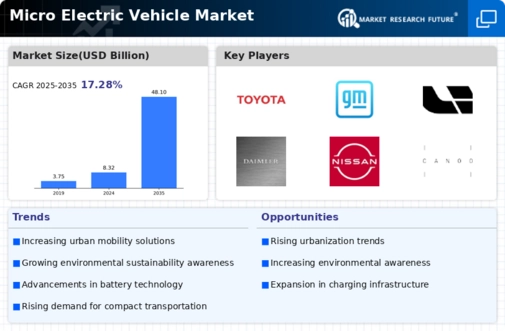Urbanization and Traffic Congestion
The ongoing trend of urbanization is a significant driver for the Micro Electric Vehicle Market. As cities become more densely populated, traffic congestion is escalating, leading to a pressing need for efficient transportation solutions. Micro electric vehicles offer a practical alternative for navigating crowded urban environments, providing agility and ease of parking. In 2025, it is anticipated that urban areas will see a 15% increase in the adoption of micro electric vehicles as commuters seek to avoid the frustrations of traditional vehicular traffic. This shift not only alleviates congestion but also contributes to improved air quality, further enhancing the appeal of micro electric vehicles.
Government Incentives and Regulations
Government policies play a pivotal role in shaping the Micro Electric Vehicle Market. Various countries are implementing incentives to promote the adoption of electric vehicles, including tax breaks, subsidies, and grants. For instance, in 2025, several regions are expected to offer financial incentives that could lower the purchase price of micro electric vehicles by up to 20%. Additionally, stringent emissions regulations are compelling manufacturers to innovate and produce cleaner vehicles. These supportive measures not only stimulate consumer interest but also encourage manufacturers to invest in the development of advanced micro electric vehicle technologies, thereby enhancing the overall market landscape.
Rising Demand for Eco-Friendly Transportation
The Micro Electric Vehicle Market is experiencing a notable surge in demand for eco-friendly transportation solutions. As urban populations grow, the need for sustainable mobility options becomes increasingly pressing. In 2025, it is estimated that the market for micro electric vehicles will reach a valuation of approximately 10 billion USD, driven by consumers' heightened awareness of environmental issues. This shift towards greener alternatives is not merely a trend; it reflects a fundamental change in consumer preferences. The Micro Electric Vehicle Market is thus positioned to benefit from this growing demand, as more individuals seek to reduce their carbon footprints while navigating urban environments.
Technological Innovations in Battery Technology
Advancements in battery technology are significantly influencing the Micro Electric Vehicle Market. The development of high-capacity, lightweight batteries is enabling micro electric vehicles to achieve longer ranges and faster charging times. In 2025, it is projected that battery costs will decrease by approximately 30%, making electric vehicles more accessible to a broader audience. This technological progress not only enhances the performance of micro electric vehicles but also addresses consumer concerns regarding range anxiety. As battery technology continues to evolve, the Micro Electric Vehicle Market is likely to witness increased adoption rates, as consumers become more confident in the capabilities of these vehicles.
Consumer Preference for Compact Mobility Solutions
There is a discernible shift in consumer preferences towards compact mobility solutions, which is propelling the Micro Electric Vehicle Market. As urban dwellers prioritize convenience and efficiency, micro electric vehicles are increasingly viewed as ideal options for short-distance travel. In 2025, it is expected that the market share of micro electric vehicles will expand by 25%, reflecting a growing acceptance of these vehicles as viable alternatives to traditional cars. This trend is particularly pronounced among younger consumers, who are more inclined to embrace innovative transportation methods. The Micro Electric Vehicle Market is thus well-positioned to capitalize on this evolving consumer landscape.


















Leave a Comment